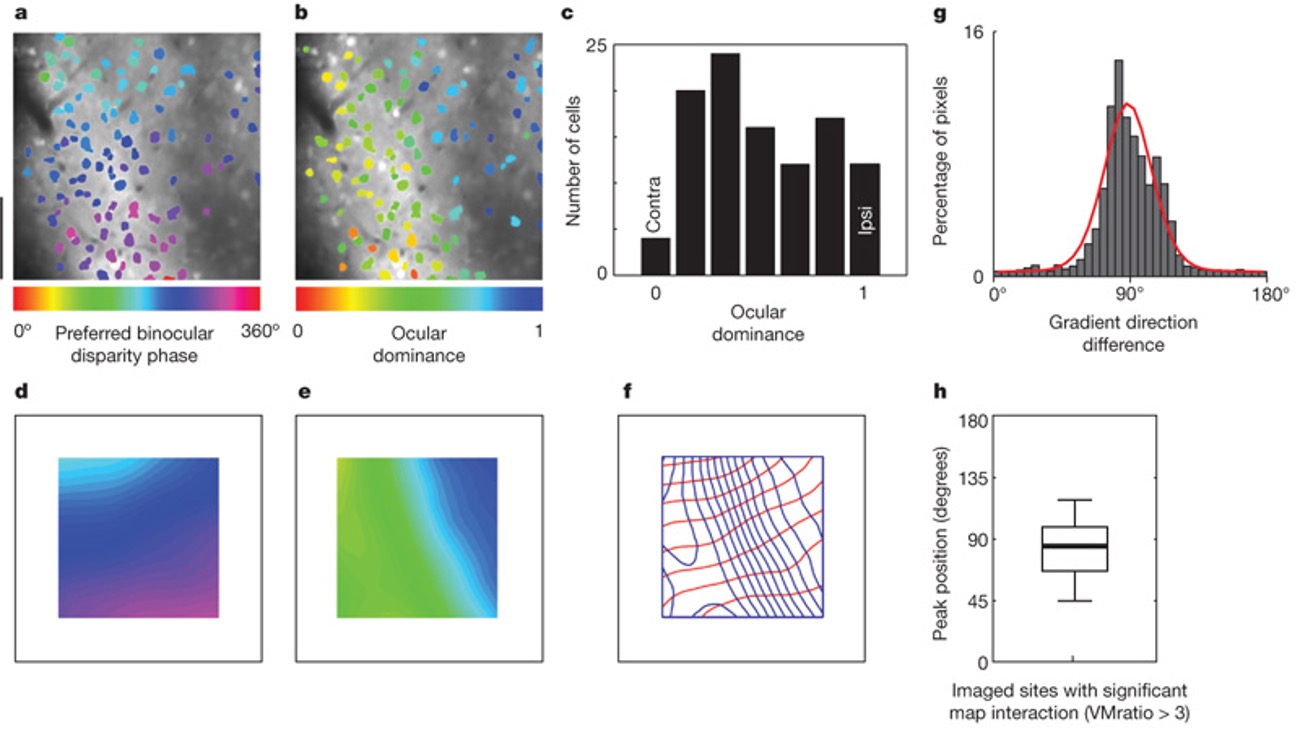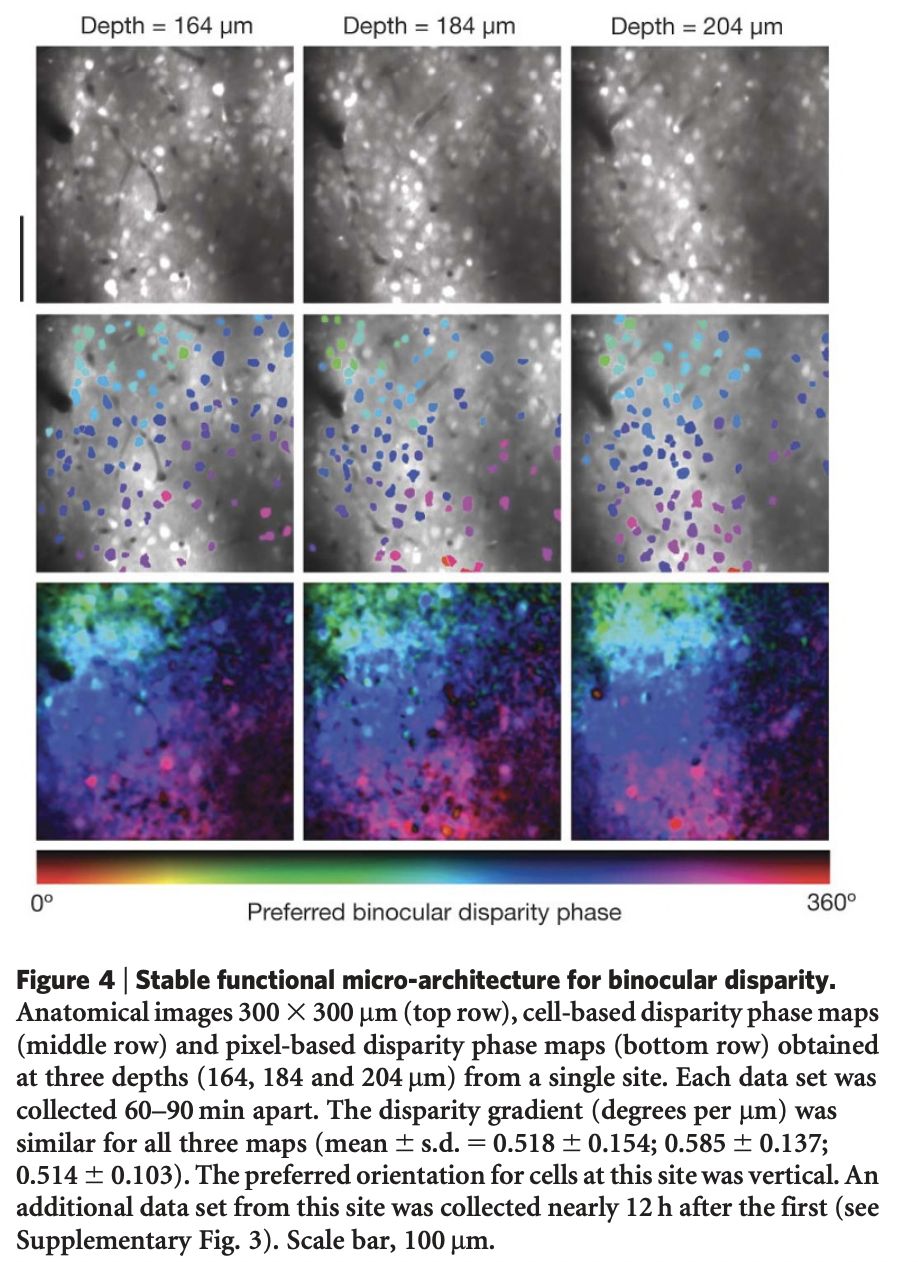Abstract:
In invertebrate predators such as the praying mantis and vertebrate predators such as wild cats the ability to detect small differences in inter-ocular retinal disparities is a critical means for accurately determining the depth of moving objects such as prey1. In mammals, the first neurons along the visual pathway that encode binocular disparities are found in the visual cortex. However, a precise functional architecture for binocular disparity has never been demonstrated in any species, and coarse maps for disparity have been found in only one primate species2,3. Moreover, the dominant approach for assaying the developmental plasticity of binocular cortical neurons used monocular tests of ocular dominance to infer binocular function4. The few studies that examined the relationship between ocular dominance and binocular disparity of individual cells used single-unit recordings and have provided conflicting results regarding whether ocular dominance can predict the selectivity or sensitivity to binocular disparity5,6,7,8,9. We used two-photon calcium imaging to sample the response to monocular and binocular visual stimuli from nearly every adjacent neuron in a small region of the cat visual cortex, area 18. Here we show that local circuits for ocular dominance always have smooth and graded transitions from one apparently monocular functional domain to an adjacent binocular region. Most unexpectedly, we discovered a new map in the cat visual cortex that had a precise functional micro-architecture for binocular disparity selectivity. At the level of single cells, ocular dominance was unrelated to binocular disparity selectivity or sensitivity. When the local maps for ocular dominance and binocular disparity both had measurable gradients at a given cortical site, the two gradient directions were orthogonal to each other. Together, these results indicate that, from the perspective of the spiking activity of individual neurons, ocular dominance cannot predict binocular disparity tuning. However, the precise local arrangement of ocular dominance and binocular disparity maps provide new clues regarding how monocular and binocular depth cues may be combined and decoded.

Method Summary:
Cats (postnatal days 36–49) were anaesthetized with isoflurane (1–2% in surgery, 0.5–1.0% during imaging)22 and paralysed with vecuronium bromide22. A craniotomy was performed over area 18 of the visual cortex, the dura reflected, and the underlying cortex covered with agarose. Movement of the brain from respiratory and heart-beat pulsations were negligible (Supplementary Fig. 8). The cell-permeant calcium indicator Oregon Green 488 Bapta-1 AM (1 mM) was prepared22,30 and co-loaded with 40 mM Alexa Fluor 594 into a glass patch pipette (2.5 mm diameter tip). Under continuous visual guidance, the pipette tip was advanced 200–250 mm below the cortical surface and the indicators were then pressure-ejected (5–10 psi). This particular method of loading produces minimal staining of glial cells (see ref. 22) but it is possible that some of the stained cells in the present study were not neuronal. Fluorescence was monitored with a custom-built microscope (Prairie Technologies) coupled with a Mai Tai XF (Newport Spectra-Physics) mode-locked Ti:sapphire laser (850 nm or 920 nm). Drifting sine-wave gratings (2 Hz, 50% contrast) were presented on a CRT (100 Hz refresh rate) in a variety of configurations for orientation, direction of motion, spatial frequency, ocularity (left or right eye, for ocular dominance), and eight inter-ocular spatial phase disparities (0u, 45u, 90u, 135u, 180u, 225u, 270u, 315u). For ocular dominance and binocular disparity assays, animals viewed the monoptic and dichoptic visual stimuli through ultra-fast ferroelectric liquid crystal shutters (7 kHz switching time, 1,000:1 extinction contrast ratio, DisplayTech). Each stimulus period (8 s) was preceded by an equal blank period, repeated 3–8 times. Coarse retinotopic positions of monocular receptive fields were determined by using 5u wide flashing bars of light or strips of gratings at ten retinotopic positions. Two-photon images were analysed in Matlab (Mathworks), see Methods.
